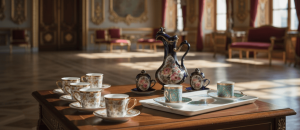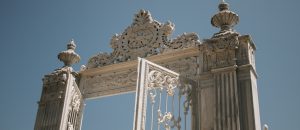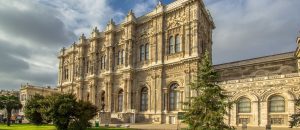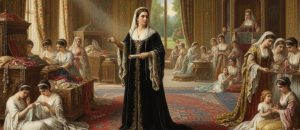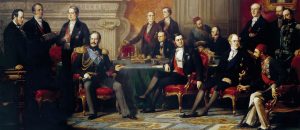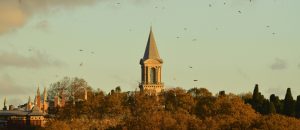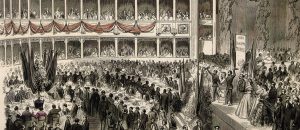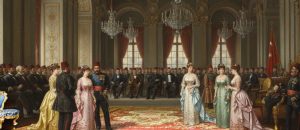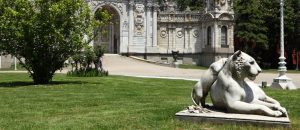Your visit to Dolmabahçe Palace should not end when you exit the palace’s monumental gates. This is because the palace is not a standalone structure; it is the heart of a living, breathing “Imperial Quarter” which includes structures like the Clock Tower, the Bezmiâlem Valide Sultan Mosque, the Akaretler Row Houses, and the Naval Museum. A short walking tour along this orbit after your palace visit offers a holistic experience that allows you to understand how the influence of Dolmabahçe shaped the urban, social, and military life of modern Istanbul, extending beyond its own walls. Here is a thematic exploration route you can follow in the palace’s orbit.
Route Start: Dolmabahçe Palace Exit (Treasury Gate)
When you complete your palace tour and exit through the Treasury Gate, you will find yourself in the center of this historic quarter. Now it is time to explore!
1st Stop: Dolmabahçe Clock Tower (Symbol of Modern Time)
Where?: The elegant and tall tower you will see immediately to your right upon exiting the palace.
What is the Connection?: This tower was commissioned by Sultan Abdülhamid II as part of the palace complex. It is not just an aesthetic element, but also a monumental symbol of the Empire’s shift from the traditional, ezan (call to prayer)-based time concept to the European standard time zone (alafranga saat).
What Should You Look For?: Note the clocks on the four sides of the tower, the Ottoman tughras (sultan’s signature), and the elegant Neo-Baroque stonework. This is evidence of how Westernization changed even the perception of time. [Link: -> /the-masters-of-time-dolmabahces-clock-collection-are-the-tick-tocks-of-westernization]
2nd Stop: Bezmiâlem Valide Sultan Mosque (Alliance of Palace and Mosque)
Where?: Right across from the Clock Tower, on the other side of the road.
What is the Connection?: This structure, also known as Dolmabahçe Mosque, was initiated by Bezmiâlem Valide Sultan, the mother of Sultan Abdülmecid, and completed by her son. The close proximity of the palace and the mosque demonstrates the continuation of traditional rituals where the Sultan (Padişah) appeared before the public during religious ceremonies, such as the Friday Procession (Cuma Selamlığı), thereby reinforcing his identity as Caliph (Halifelik).
What Should You Look For?: Examine the elegant, Baroque, and Empire-style architecture of this mosque, which bears the signature of the Balyan family, distinguishing it from classical Ottoman mosques. The circular window design creates unity with the architectural language of the palace. [Link: -> /the-balyans-against-sinan-why-did-the-ortakoy-mosque-challenge-mosque-architecture]
3rd Stop: Akaretler Row Houses (The Birth of Modern Housing)
Where?: Historic buildings lined up on both sides of the slope going up from the mosque towards Şairler Parkı (Poets’ Park).
What is the Connection?: This was Istanbul’s first planned mass housing project and was built as lodgings for high-ranking officials (ağalar) working at Dolmabahçe Palace. The palace was not only an administrative center but also a “city founder,” creating a modern living space around itself.
What Should You Look For?: Notice the repetitive order and symmetry on the Neoclassical facades of the buildings. This is the first example of planned urbanism and a break away from the traditional Ottoman neighborhood texture. Walking down this street, which today hosts stylish cafes and shops, is a great opportunity to feel how history intertwines with modern life. [Link: -> /the-city-in-the-shadow-of-the-palace-how-the-clock-tower-and-akaretler-shaped-modern-istanbul]
4th Stop (Optional): Naval Museum (The Maritime Power of the Empire)
Where?: On the left side of the road as you walk from the palace towards Beşiktaş Pier.
What is the Connection?: Dolmabahçe Palace is the symbol of an empire that turned its face towards the sea. Visiting the Naval Museum, which is Turkey’s largest maritime museum right next door, is an excellent step that complements this maritime vision. The historical imperial caïques (saltanat kayıkları) exhibited in the museum are the very elegant vessels that once transported Sultans and their guests to the Dolmabahçe pier.
What Should You Look For?: Focus specifically on the massive imperial caïques (saltanat kayıkları), used by the Sultans, adorned with carvings and pavilions (köşkler), and pulled by dozens of oarsmen. This is concrete evidence of the palace’s power and splendor at sea.
Conclusion: A Holistic Historical Experience
When you combine your Dolmabahçe Palace tour with this “Imperial Quarter” tour of the surroundings, you see not just a palace, but a holistic portrait of an entire era. While the palace itself speaks of politics and art, the Clock Tower speaks of time, the Mosque of religious life, the Akaretler of social life, and the Naval Museum of military power. This short walking route will enrich your Dolmabahçe experience and show you in three dimensions how an empire reshaped its final capital.








